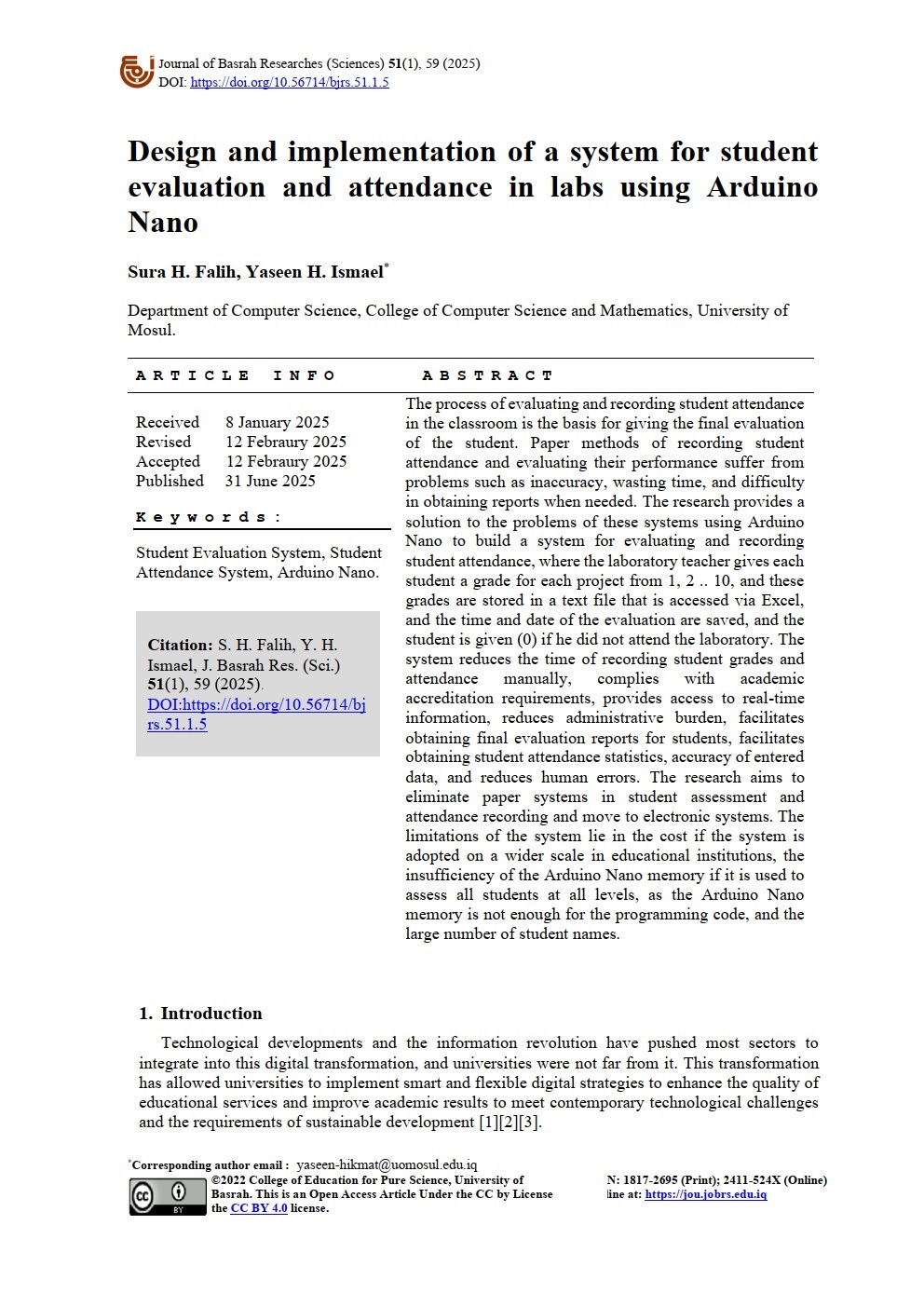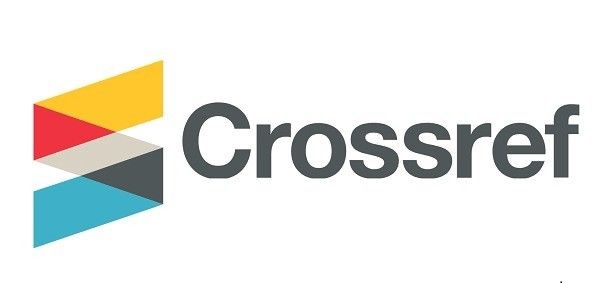Design and implementation of a system for student evaluation and attendance in labs using Arduino Nano
Keywords:
Student evaluation system, Student attendance system, Arduino NanoAbstract
The process of evaluating and recording student attendance in the classroom is the basis for giving the final evaluation of the student. Paper methods of recording student attendance and evaluating their performance suffer from problems such as inaccuracy, wasting time, and difficulty in obtaining reports when needed. The research provides a solution to the problems of these systems using Arduino Nano to build a system for evaluating and recording student attendance, where the laboratory teacher gives each student a grade for each project from 1, 2 .. 10, and these grades are stored in a text file that is accessed via Excel, and the time and date of the evaluation are saved, and the student is given (0) if he did not attend the laboratory. The system reduces the time of recording student grades and attendance manually, complies with academic accreditation requirements, provides access to real-time information, reduces administrative burden, facilitates obtaining final evaluation reports for students, facilitates obtaining student attendance statistics, accuracy of entered data, and reduces human errors. The research aims to eliminate paper systems in student assessment and attendance recording and move to electronic systems. The limitations of the system lie in the cost if the system is adopted on a wider scale in educational institutions, the insufficiency of the Arduino Nano memory if it is used to assess all students at all levels, as the Arduino Nano memory is not enough for the programming code, and the large number of student names.
Downloads
References
M. Kaka, “The digitization of Iraqi universities requirements in the view of the digital transformation initiatives,” Human Sciences Research Journal, vol. 34, pp. 721-740, 2023. DOI: Available: https://www.scribd.com/document/687659403/392-Published-Paper.
O.O. Mohammed and S.M. Mohi-Aldeen, “Designing an electronic platform for the distribution and managing undergraduate projects,” Al-Rafidain Journal of Computer Sciences and Mathematics, 2021. Available: https://www.rafidainjournals.com.
W.A. Alhadidiu and S.M. Mohi-Aldeen, “Land Ownership Management System in Mosul City,” Al-Rafidain Journal of Computer Sciences and Mathematics (RJCM), vol. 18, no. 1, pp. 74-83, 2024. DOI: https://doi.org/10.33899/csmj.2024.144939.1097.
A. Shaikh, S. Salian, A. Gupta, A. Gairola, and U. Goradiya, “Web Application for Student Performance Evaluation and Remuneration System,” Int. J. Sci. Res. Comput. Sci. Eng. Inform. Technol., vol. 10, no. 2, pp. 629-633, 2023. DOI: https://doi.org/10.32628/CSEIT23902100.
G. Bharathy, S. Bhavanisankari, and T. Tamilselvi, “Smart Attendance Monitoring System using IoT and RFID,” Int. J. Adv. Eng. Manag., vol. 3, no. 6, pp. 1307-1313, 2021. DOI: https://doi.org/10.35629/5252-030613071313.
N. Malhotra, “Attendance and Assessment System,” J. Emerg. Technol. Innov. Res. (JETIR), vol. 5, no. 8, pp. 65-70, 2018. Available: http://www.jetir.org.
A. Aziz, M. Golap, and M. Hashem, “Student’s Academic Performance Evaluation Method Using Fuzzy Logic System,” Proc. 1st Int. Conf. Adv. Sci. Eng. Robot. Technol. (ICASERT), pp. 1-6, 2019. DOI: https://doi.org/10.1109/ICASERT.2019.8934496.
P. Addagatla, “Arduino based Student Attendance Monitoring System using GSM,” Int. J. Eng. Res. Technol. (IJERT), vol. 8, no. 7, pp. 338-344, 2019. Available: http://www.ijert.org.
M. Wen, N. Ahmad, and S. Ruslan, “Arduino based outing and attendance system for boarding school students,” Indonesian J. Electr. Eng. Comput. Sci., vol. 20, no. 2, pp. 1053-1061, 2020. DOI: http://ijeecs.iaescore.com.
N. Abd El-Mawla, M. Ismaiel, and ASQR Team, “Smart Attendance System Using QR-Code, Finger Print and Face Recognition,” Nile J. Commun. Comput. Sci., vol. 2, no. 1, pp. 1-16, 2022. DOI: https://njccs.journals.ekb.eg.
G.P. Jadhav, P. Gondchawar, S.V. Khedkar, V. Darshanala, and V.S. Ingole, “Student Performance Evaluation System Web Application,” Int. J. Adv. Res. Sci. Commun. Technol., vol. 2, no. 6, pp. 417-427, 2022.
N. Alruwais and M. Zakariah, “Evaluating Student Knowledge Assessment Using Machine Learning Techniques,” Sustainability, vol. 15, no. 7, p. 6229, 2023. DOI: https://doi.org/10.3390/su15076229.
S. Mothukuru and K. Kaur, “Rechargeable Smart Cane using Arduino Nano,” SSRN, 2023. Available: https://ssrn.com/abstract=4937982.
A. Sizoh, I. Ejimofor, E. Alagbu, O. Obianyo, and U. Ebih, “Design and Construction of Arduino-Based Experimental Training Kit,” Int. J. Res. Publ. Rev., vol. 3, no. 4, pp. 389-399, 2022. Available: https://ijrpr.com/uploads/V3ISSUE4/IJRPR3312.pdf.
S. Raj, K. Srivasan, R. Vijay, K. Prasanth, and B. Pranav, “Real-Time Clock Using Arduino,” Dogo Rangsang Res. J., vol. 13, no. 5, pp. 82-87, 2023. Available: https://www.journal-dogorangsang.in/no_1_Online_23/15_may.pdf.
A.H. Ali and R.Z. Mahmood, “Bresenham’s Line and Circle Drawing Algorithm using FPGA,” Rafidain J. Comput. Sci. Math., vol. 15, no. 2, pp. 39-49, 2021. Available: https://csmj.mosuljournals.com/index.php/csmj/article/view/752/752.
S.H. Falih and Y.H. Ismael, “Student attendance and evaluation system: A review,” Al-Rafidain J. Comput. Sci. Math. (RJCM), vol. 6, no. 1, 2025.
T. Prajapati, V. Dahale, K. Ingole, and S. Helambe, “Noise Informer Using Arduino Nano and GSM Module,” Int. J. Res. Eng. Appl. Manag. (IJREAM), Special Issue - NCRICE, pp. 77-80, 2019. Available: http://www.farnell.com/datasheets/1682238.pdf.

Downloads
Published
Issue
Section
License
Copyright (c) 2025 Basrah Researches Sciences

This work is licensed under a Creative Commons Attribution 4.0 International License.







